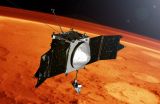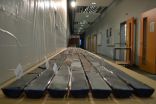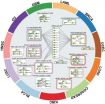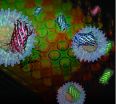(Press-News.org) Irvine, Calif., Dec. 15, 2014 - Dangerously high levels of air pollutants are being released in Mecca during the hajj, the annual holy pilgrimage in which millions of Muslims on foot and in vehicles converge on the Saudi Arabian city, according to findings reported today at the American Geophysical Union meeting in San Francisco.
"Hajj is like nothing else on the planet. You have 3 to 4 million people - a whole good-sized city - coming into an already existing city," said Isobel Simpson, a UC Irvine research chemist in the Nobel Prize-winning Rowland-Blake atmospheric chemistry laboratory. "The problem is that this intensifies the pollution that already exists. We measured among the highest concentrations our group has ever measured in urban areas - and we've studied 75 cities around the world in the past two decades."
Scientists from UCI, King Abdulaziz University in Saudi Arabia, the University of Karachi in Pakistan, the New York State Department of Health's Wadsworth Center, and the University at Albany in New York captured and analyzed air samples during the 2012 and 2013 hajjes on roadsides; near massive, air-conditioned tents; and in narrow tunnels that funnel people to the Grand Mosque, the world's largest, in the heart of Mecca.
The worst spot was inside the Al-Masjid Al-Haram tunnel, where pilgrims on foot, hotel workers and security personnel are exposed to fumes from idling vehicles, often for hours. The highest carbon monoxide level - 57,000 parts per billion - was recorded in this tunnel during October 2012. That's more than 300 times regional background levels.
Heart attacks are a major concern linked to such exposure: The risk of heart failure hospitalization or death rises sharply as the amount of carbon monoxide in the air escalates, the researchers note in a paper published in the journal Environmental Science & Technology. Headaches, dizziness and nausea have also been associated with inhaling carbon monoxide.
"There's carbon monoxide that increases the risk of heart failure. There's benzene that causes narcosis and leukemia," Simpson said. "But the other way to look at it is that people are not just breathing in benzene or CO, they're breathing in hundreds of components of smog and soot."
The scientists detected a stew of unhealthy chemicals, many connected to serious illnesses by the World Health Organization and others.
"Air pollution is the cause of one in eight deaths and has now become the single biggest environmental health risk globally," said Haider Khwaja of the University at Albany. "There were 4.3 million deaths in 2012 due to indoor air pollution and 3.7 million deaths because of outdoor air pollution, according to WHO. And more than 90 percent of those deaths and lost life years occur in developing countries."
Khwaja experienced sooty air pollution firsthand as a child in Karachi, Pakistan, and saw his elderly father return from the hajj with a wracking cough that took weeks to clear. He and fellow researchers braved the tunnels and roads to take air samples and install continuous monitors in Mecca.
"Suffocating," he said of the air quality.
In addition to the high smog-forming measurements, the team in follow-up work found alarming levels of black carbon and fine particulates that sink deep into lungs. Once the hajj was over, concentrations of all contaminants fell but were still comparable to those in other large cities with poor air quality. Just as unhealthy "bad air" days once plagued Greater Los Angeles, research is now showing degraded air in the oil-rich, sunny Arabian Peninsula and elsewhere in the Middle East. Because the number of pilgrims and permanent residents is increasing, the scientists recommend reducing emissions by targeting fossil fuel sources.
Besides vehicle exhaust, other likely culprits include gasoline high in benzene, a lack of vapor locks around gas station fuel nozzles, and older cars with disintegrating brake liners and other parts. Coolants used for air-conditioned tents sleeping up to 40 people also contribute to greenhouse gas buildup. And the dearth of regulations exacerbates these problems.
The researchers said that Saudi officials are aware of the issues and taking steps to address them, such as working to reduce benzene in area gasoline supplies. Directing Mecca pedestrians and vehicles to separate tunnels would be optimal. In addition, clearing the region's air with time-tested technologies used elsewhere in the world could sharply reduce pollution and save lives.
"This is a major public health problem, and the positive news is that some of the answers are very much within reach, like putting rubber seals on nozzles at gas stations to reduce leaks," Simpson said. "It's a simple, doable solution."
INFORMATION:
About the University of California, Irvine: Founded in 1965, UCI is the youngest member of the prestigious Association of American Universities. The campus has produced three Nobel laureates and is known for its academic achievement, premier research, innovation and anteater mascot. Led by Chancellor Howard Gillman, UCI has more than 30,000 students and offers 192 degree programs. Located in one of the world's safest and most economically vibrant communities, it's Orange County's second-largest employer, contributing $4.8 billion annually to the local economy.
Media access: Radio programs/stations may, for a fee, use an on-campus ISDN line to interview UC Irvine faculty and experts, subject to availability and university approval. For more UC Irvine news, visit news.uci.edu. Additional resources for journalists may be found at communications.uci.edu/for-journalists.
Early discoveries by NASA's newest Mars orbiter are starting to reveal key features about the loss of the planet's atmosphere to space over time.
The findings are among the first returns from NASA's Mars Atmosphere and Volatile Evolution (MAVEN) mission, which entered its science phase on Nov. 16. The observations reveal a new process by which the solar wind can penetrate deep into a planetary atmosphere. They include the first comprehensive measurements of the composition of Mars' upper atmosphere and electrically charged ionosphere. The results also offer an unprecedented ...
A breast cancer specialist and clinical researcher at Women & Infants Hospital of Rhode Island presented research yesterday at the 2014 San Antonio Breast Cancer Symposium showing that adding either the chemotherapy drug carboplatin or the blood vessel-targeting drug bevacizumab to the standard treatment of chemotherapy before surgery helped women who have the basal-like subtype of triple-negative breast cancer.
"We found that adding either carboplatin or bevacizumab to standard preoperative chemotherapy increased pathologic complete response rates for women with basal-like ...
Scientists from the Department of Energy's Pacific Northwest National Laboratory will present a variety of research at the 2014 American Geophysical Union Fall Meeting, which runs Monday, Dec. 15 through Friday, Dec. 19 at the Moscone Convention Center in San Francisco. Noteworthy PNNL research presentations include the following topics:
Even with global warming cold air outbreaks will remain
Just because the climate is warming doesn't mean Cold Air Outbreaks are going away, especially in Southwestern Canada and Northwestern United States. Overall, global climate models ...
Leading conservation scientists from around the world have called for a substantial role for nuclear power in future energy-generating scenarios in order to mitigate climate change and protect biodiversity.
In an open letter to environmentalists with more than 60 signatories, the scientists ask the environmental community to "weigh up the pros and cons of different energy sources using objective evidence and pragmatic trade-offs, rather than simply relying on idealistic perceptions of what is 'green' ".
Organized by ecologists Professor Barry Brook and Professor Corey ...
SALT LAKE CITY, Dec. 15, 2014 - The rate at which carbon emissions warmed Earth's climate almost 56 million years ago resembles modern, human-caused global warming much more than previously believed, but involved two pulses of carbon to the atmosphere, University of Utah researchers and their colleagues found.
The findings mean the so-called Paleocene-Eocene thermal maximum, or PETM, can provide clues to the future of modern climate change. The good news: Earth and most species survived. The bad news: It took millennia to recover from the episode, when temperatures rose ...
PROVIDENCE, R.I. [Brown University] -- Using a computer algorithm that can sift through mounds of genetic data, researchers from Brown University have identified several networks of genes that, when hit by a mutation, could play a role in the development of multiple types of cancer.
The algorithm, called Hotnet2, was used to analyze genetic data from 12 different types of cancer assembled as part of the pan-cancer project of The Cancer Genome Atlas (TCGA). The research looked at somatic mutations -- those that occur in cells during one's lifetime -- and not genetic variants ...
Cold Spring Harbor, NY - The next time you are in a crowded room, or a meeting, or even at the park with your kids, take a look around. How many people are on their phone? Distractions invade every aspect of our lives. Status updates, text messages, email notifications all threaten to steal our attention away from the moment. While we fight the urge to check the phone, our brains are making constant judgment calls about where to focus attention. The brain must continually filter important information from irrelevant interference.
Scientists have hypothesized for decades ...
AMHERST, Mass. - Traditional genomic, proteomic and other screening methods currently used to characterize drug mechanisms are time-consuming and require special equipment, but now researchers led by chemist Vincent Rotello at the University of Massachusetts Amherst offer a multi-channel sensor method using gold nanoparticles that can accurately profile various anti-cancer drugs and their mechanisms in minutes.
As Rotello and his doctoral graduate student Le Ngoc, one of the lead authors, explain, to discover a new drug for any disease, researchers must screen billions ...
Researchers have released one of the most comprehensive assessments of the timing and amount of greenhouse gas emissions that each of the world's major economies could produce under different scenarios, i.e. without new climate policies, for the currently discussed pledges, and under a scenario that limits future temperature rise to 2°C. "The pledges made so far lead to earlier emission peaking in many countries, with 1-1.5 °C less total warming than without these policies, but not sufficient to meet the 2oC target. Under the proposed commitments, cumulative CO2 ...
Advocates of biotech crops and those who favor traditional farming practices such as crop diversity often seem worlds apart, but a new study shows that these two approaches can be compatible. An international team led by Chinese scientists and Bruce Tabashnik at the University of Arizona's College of Agriculture and Life Sciences discovered that the diverse patchwork of crops in northern China slowed adaptation to genetically engineered cotton by a wide-ranging insect pest. The results are published in the advance online edition of Nature Biotechnology.
Genetically engineered ...





